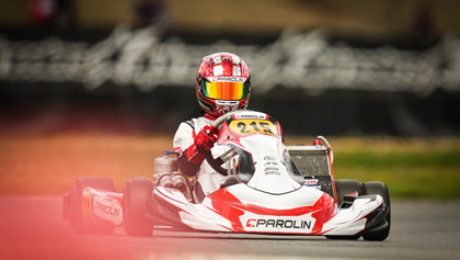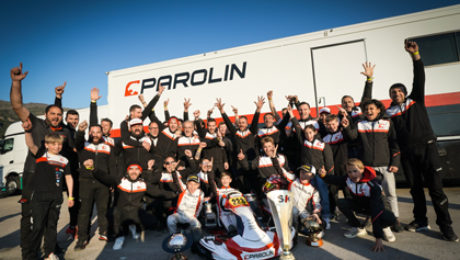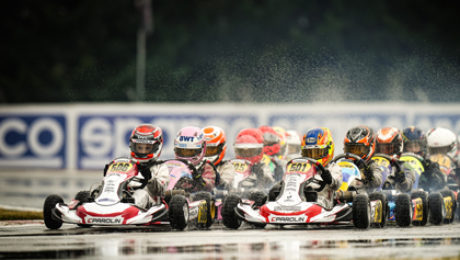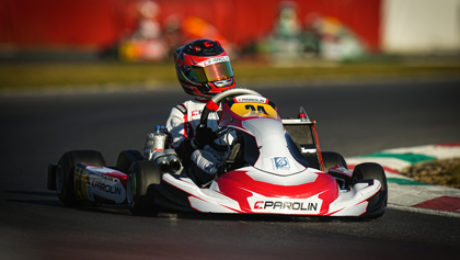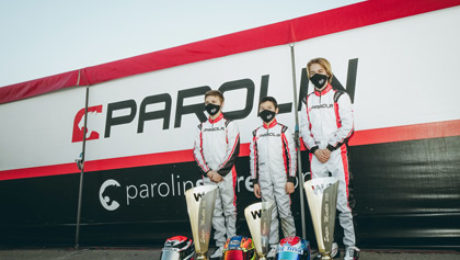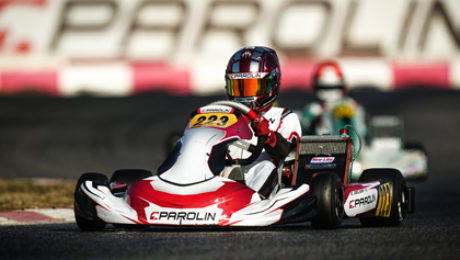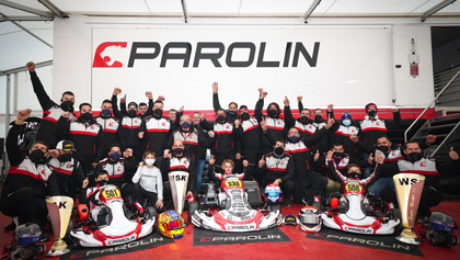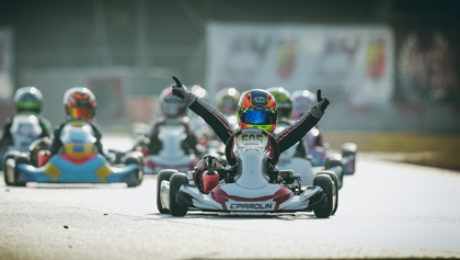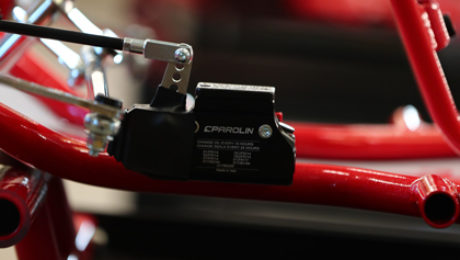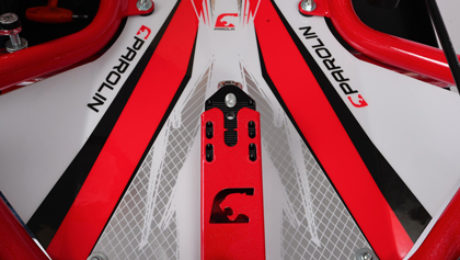C
onsidered as a series in itself as well as preparation for the FIA Karting European Championship, the Champions of the Future Euro Series started on the last weekend of March on the Portimao circuit in the south of Portugal. Enzo Deligny just missed out on the OK top three, valiantly finishing 3rd on the line and was then penalised, while Anatoly Khavalkin came 7th in the OK-Junior Final and René Lammers finished 9th.
“The Parolin Motorsport team achieved its goal in this first meeting in Portimão,” said Marco Parolin. “We have been working hard for the FIA Karting European Championship – OK and OK-Junior which will start here in a fortnight. The Portuguese track requires good preparation after an exclusively Italian start to the season. The drivers also need to familiarise themselves with this fast track. To be able to fight for 3rd position in the OK Final with Enzo Deligny is a very encouraging result. This is only the second time this year that we have used MG tyres in this category. In OK-Junior, Anatoly Khavalkin and René Lammers also showed good potential with a 5th place in Qualifying and a double top 10. We will continue our efforts in order to arrive at the European Championship running at full capacity.”
The track was wet in the middle of the week and dried out for Qualifying, but the grip was not very high. The weather remained quite good, but not warm because of the constant wind. René Lammers started with 5th position in the OK-Junior Qualifying and continued with four top fives in the heats, including two fastest laps in the race. Meanwhile, Anatoly Khavalkin made good progress from his 23rd place in Qualifying. He had a great Final race, quickly moving up to the front group and fighting for 7th position with a gain of eight positions and some very fast laps. Lammers increased the pace after a more complicated start and finally finished in 9th position. Zac Drummond made a strong comeback of 26 places from Qualifying and just missed out on the Final by finishing 37th.
In OK, Enzo Deligny had some very good heats finishing between 5th and 2nd place, but his Super Heat was not so good and he had to start down in 12th for the Final. He came back into the top five shortly after the halfway point and was back in the top three two laps before the finish with nine places gained. A penalty of 5” applied during the race dropped him back to 8th place. Maksim Orlov recovered from his 31st position in Qualifying, setting a fastest lap in one heat. Despite a turbulent race, he finished 22nd in the Final with good consistency.
The WSK Super Masters Series has just finished at the Circuito Internazionale Napoli with an intense fourth round with a large number of participants. The Parolin Racing Kart chassis put in top performances in all four categories and Parolin Motorsport recorded several outstanding successes at the end of the series. Enzo Deligny achieved a fantastic victory in OK, while Anatoly Khavalkin won in OK-Junior. Christian Costoya finished 4th in a Mini Final that went down to the wire. For his return to competition, Francesco Celenta was extremely fast in KZ2.
“We have many reasons to be happy after the competition in Sarno,” declared Marco Parolin. “Christian Costoya and Dries van Langendonck finished on the championship podium in Mini and we placed three drivers in the top 10 of the Final while the performance level of the whole team improved again. Anatoly Khavalkin managed to win in OK-Junior after a long battle and Enzo Deligny was able to get his first victory in OK with a high performance kart. Finally, Francesco Celenta’s three fastest laps in KZ2 are indicative of our competitiveness in KZ2. The team’s work has definitely paid off in terms of performance and our successes are very positive indicators less than a month before the start of the FIA Karting European Championships.”
The weather was sunny throughout the Sarno meeting, but temperatures remained cool for the region. A large field of 271 drivers entered this final round of the WSK Super Master Series. As always on the Neapolitan track, the races were exciting and hectic. Parolin was well established in the leading group in 3rd place among chassis manufacturers with strong numerical domination in the Mini class where four Parolins finished in the Final top five. The OK and OK-Junior victories were a reminder of the competitiveness of the Bassano del Grappa-based brand in the other categories.
Extended performance in Mini
The increase of the general standard of the Parolin Motorsport Mini drivers was particularly visible in Sarno. Jack Illife set the 3rd fastest time in the Qualifying session and the very young Alessandro Truchot was 6th among the 79 best specialists of the category. Bruno Gryc set two fastest laps in the heats and in the Final he gained 10 more places to 16th place. Dries Langendonck was regularly in the top two of the heats until a retirement delayed him. He still managed to finish 9th in the Final and was able to take 3rd place in the championship. William Calleja was 19th in the Qualifying Heats, but he continued to improve and reached 7th place at the end of the Final. Finally, Christian Costoya shone in the heats and fought for the Final victory. He was the leader for a long time, but then secured 4th place to finish 2nd in the championship.
Khavalkin victorious in OK-Junior
Anatoly Khavalkin had a superb meeting, regularly in the top five since Qualifying. But it was during the Final that he gave his best. After a waiting race in 2nd position, he went on the attack with three laps to go to finally take his first success of the year. He secured 4th place in the championship. Zac Drummond confirmed his very positive progress by making a superb Final climb of 11 places to finish in the top 10. It was a difficult weekend for René Lammers after qualification in 28th position as he had to retire in the Final.
OK: Deligny at the top
We hadn’t seen Enzo Deligny on track since his 6th place in Lonato in February. Very solid in Qualifying and in the Sarno heats, he was imperial in the Final. He started 9th, climbed relentlessly and took the lead after seven laps and increased his lead to celebrate his first victory at this level. On the podium, he praised the work of the team who had provided him with a perfect machine to win.
KZ2: Celenta comes back in force
Away from the circuits since his injury in Lonato at the end of January, Francesco Celenta was fast and consistent in his comeback from 29th place in Qualifying. With a total gain of 22 places, he finished 7th in the Final (+6 places) with a new fastest lap in the race.
Parolin Motorsport travelled to southern Italy to participate in the penultimate round of the WSK Super Masters Series at La Conca with 13 young drivers. The wet conditions in the Qualifying Heats and the lack of grip in the Finals made for some very special racing on a track that is usually known for its strong grip. The Parolin chassis proved to be competitive in these unusual conditions. Anatoly Khavalkin came close to the top five in OK-Junior, while Christian Costoya finished on the Mini podium just ahead of Qualifying poleman Dries van Langendonck, both of whom impressed the meeting with their speed.
“The weekend in La Conca started well, both in Mini and Junior“, said Marco Parolin. “In both categories we had good results in the dry on Friday, when the track was grippy and fast, and in the wet on Saturday, when we won the heats with four different drivers in both categories. Unfortunately the conditions on Sunday made it more difficult than expected. Compared to the previous dry conditions, the track was about four seconds slower in Mini and seven seconds slower in OKJ. Our drivers tried to maximise their results despite the difficult situation. We didn’t get the results we expected at the beginning of the weekend, but it was certainly an important learning experience for the whole team.
Dries van Langendonck and Christian Costoya performed very well in the rain with eight heat wins in total, including five fastest times. Costoya made a great comeback in the Final to finish 3rd ahead of van Langendonck and both confirmed their presence in the top three of the Super Master Series. Bruno Gryc continued to make progress with a top three in a heat and a 16th place in the Final, while Jack Illife came close to the top 10 in the heats.
Parolin chassis were once again well represented with almost 40% of the Mini field, pole position and half of the top 10 in Qualifying and the top four places in the Final with eight Parolin karts in the top 13. Parolin was the leader in terms of number of chassis in all categories and also achieved good results in OK-Junior. René Lammers was very convincing in the heats and was in the top three at the beginning of the race, but he gradually lost places. Anatoly Khavalkin had solid heats despite a retirement and continued his effort with success by reaching 6th position in the Final. Zac Drummond confirmed his potential with a win and a 2nd place in a heat. We will now head to the Naples region for the final round of the WSK Super Master Series next weekend in Sarno.“
The detailed performances of the Parolin Motorsport drivers at La Conca allow a better appreciation of the competitiveness of the team.
OK-Junior
René Lammers remained well placed in the provisional Super Master standings with his 4th position. He had moved up 10 places during the heats with a win and a 2nd position with two fastest laps in the race. 2nd on the starting grid of the Final, he lost a few places as the laps went by. Anatoly Khavalkin, who had been in the top four until then, was delayed by a retirement in the last heat. He drove a good Final where a gain of three places brought him to the 6th position. Zac Drummond’s great comeback after the heats was affected by a retirement and a penalty, but he still secured 16th place in the Final.
Mini
Dries van Langendonck had dominated the Mini category from Qualifying to the heats, making a faultless run in the lead and setting three fastest times. The start of the Final did not go in his favour, but he attacked relentlessly to come back to 4th place. Christian Costoya started at the same pace. A problem in his third heat thwarted his progress. 9th on the starting grid of the Final, he drove a very good race to take 3rd position on the podium. Bruno Gryc performed well and climbed 21 places to 16th in the Final, as did Jack Illife in 17th place after a difficult Final.
The Champions of the Future by RGMMC Winter Series has just taken place on the new Italian circuit of Franciacorta near Milan with tyres identical to those of the forthcoming FIA Karting Championships: MG in OK and Vega in OK-Junior. Anatoly Khavalkin dominated the Junior class before finishing on the podium in a very competitive Final, while René Lammers also proved to be very competitive in adversity. Parolin Motorsport’s level of performance was confirmed by Maksim Orlov’s top three in OK in Qualifying and in the heats.
Marco Parolin summed up the meeting:
“FIA Karting competitions are the main focus of the season for the international categories. Therefore it was interesting for us to get to know the particularities of the Franciacorta track where the European OK and OK-Junior Championship will finish in July. It was also an opportunity to drive on FIA Karting tyres, even though we did not have Prime tyres in KZ2. So there was a lot of work to do this weekend. The 1300m circuit is fast and contact often results in crashes and retirements. The races are very competitive right up to the finish line. These are very demanding conditions for the young drivers who still have to find their bearings. We can be satisfied with the work done by the technical team. Maksim Orlov was very competitive in OK with his 3rd place in Qualifying and two top three finishes in the heats. Unfortunately, he was not able to do so on Sunday, probably because of different grip parameters in an area we cannot control. Anatoly Khavalkin was on top throughout the weekend in OK-Junior. The Final was very lively and he finished 3rd after having completed 14 of the 19 laps in the lead. René Lammers was delayed by a retirement in the first race and had to withdraw again after he had come back to 9th place in the Final. I would like to salute the perseverance of Zac Drummond who regained 27 places between Qualifying and the Final. Overall it was an interesting experience with lessons to be learnt, but our Parolin / TM Racing teams confirmed their top performances.“
OK-Junior
Anatoly Khavalkin:
pole position in Qualifying, three heat wins and a fastest lap, leader of the Super Heats, 3rd in the Final, leading 14 of the 19 laps.
René Lammers:
9th in Qualifying, retirement in Heat 1, 2nd in Heat 3, 5th in Super Heat 1 (+5 pl), retirement in Final (P9 +10 pl).
Zac Drummond:
53rd in Qualifying, 29th (+24 pl) in heats, 26th in Final (+8 pl).
OK
Maksim Orlov:
3rd in Qualifying, two top threes in heats, 10th after Super Heats, 22nd in Final with a penalty for badly positioned spoiler.
• Sparco and Parolin Racing Kart, two historic international motorsport companies, establish a three-year partnership.
• Sparco will offer its tailor-made services by providing technical race clothing and teamwear for karters, staff and clients.
• The safety, comfort and innovative design of Sparco products combine with the distinctive style and identity of Parolin.
The start of the 2022 international kart season coincides with the start of the technical collaboration between Sparco® and Parolin Racing Kart, two leading companies in the kart sector.
Thanks to the considerable experience gained in 45 years of activity, Sparco® will produce all the technical clothing and teamwear for the team and its customers, through a dedicated line under the Parolin brand, which will benefit from an important visibility on kart tracks all over the world and from a worldwide distribution.
Safety, comfort and design have always distinguished Sparco® products. To this distinctive element is added a distinctive style designed ad hoc, in line with Parolin’s identity.
Marco Parolin, Parolin Racing Kart Marketing Manager: “We are thrilled to have signed this partnership with Sparco, one of the most prestigious brands on motorsport’s international scene. The product line specifically developed for Parolin is able to fully satisfy the needs of our team and of our sales network. We both aim at the utmost quality and at the attention to details, which are fundamental elements to make a difference in our field”.
Niccolò Bellazzini – Brand Manager Sparco®: “The signing of this important agreement is a further step towards strengthening Sparco®’s market leadership in a strategic business such as karting. We’re observing consistent growth in the sector and in the number of participants in the various international championships, and this is a sign of the extreme vitality of motorsport. The combination of our brand with that of a team of primary stature such as Parolin Racing Kart is a clear sign of our growing level of investment in this segment.”
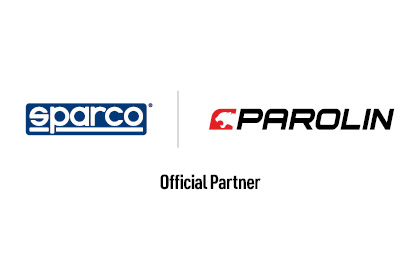
In a very tough WSK Super Master Series Round 2, Parolin Motorsport showed a remarkable level of competitiveness in all categories. Of course, results were more difficult to achieve with a record field of over 350 participants. Despite several setbacks, Parolin Motorsport reached 6th place in OK with rookie Enzo Deligny, René Lammers held on to 3rd place in the Junior ranking while Anatoly Khavalkin finished 6th in the Final. Dries van Langendonck was on the Mini podium followed by Christian Costoya, both in the top three of the Super Master Series.
“WSK Promotion can be proud to have broken its absolute participation record this weekend“, said Marco Parolin. “This is a well-deserved reward for the quality of the organisation and a very positive indication for high-level karting. The competition was more demanding due to the high number of competitors competing simultaneously on the track, especially during the 46 Qualifying Heats and the eight Prefinals. Fortunately, our Parolin/TM Racing equipment performed very well throughout the meeting.
Despite their best efforts, our drivers were not always able to avoid incidents and penalties. It was a difficult exercise and we had to be very successful in order to reach the top positions. I am universally satisfied with the progress of our drivers. We can already see some young talents blossoming and the rest of the season will bring us some pleasant surprises. With 48 Parolin chassis in the starting line-up, our brand is in an enviable position at this level with a third of the field and four Parolin karts in the Final top five.“
In terms of results, the KZ2 results did not match the true performance level of Parolin Motorsport. Lorenzo Travisanutto was very fast and set three best laps in the race after his superb 3rd place out of 93 participants. This was not enough to allow him to shine in the Final because of a retirement and four penalties.
In OK, the two rookies did a good job. Enzo Deligny was 6th and Maksim Orlov 11th out of 60, both had solid heats before following each other to 3rd and 4th in the Prefinal. Enzo continued his progress in the Final by finishing 6th while Maksim had to retire while making progress towards the top 10.
Anatoly Khavalkin managed to regain 16 places during the OK-Junior Qualifying Heats to climb to 2nd place out of 90 participants. He finished the Final in 6th position, which moved him up six places in the provisional series ranking. René Lammers had regained 24 positions in the heats by finishing 4th, but the Final stages were not favourable to him and he ended with a retirement. He remains in the top three of the ranking. Zac Drummond had a very solid run from his distant 61st time. After avoiding all the pitfalls in the heats, he moved up 38 places and continued his climb by moving up another 12 positions to 13th in the Final.
The Mini category had 108 participants, a record. Christian Costoya and Dries van Langendonck confirmed their talents in the face of strong opposition. With a total of six heat wins between them, they achieved their objectives. Christian won his Prefinal before taking a rewarding 4th Final position after an intense battle. Dries played a great card in a hectic last lap to reach the third step of the podium. They follow each other in 2nd and 3rd place in the series standings at the halfway point.
Jack Illife stepped up his game in a consistent performance that took him to 7th place in the Final. William Calleja posted three fastest laps in the heats, but dropped out in his Prefinal. A fine 10-place recovery allowed him to reach 13th position in the Final. Bruno Gryc developed positively during the entire event to finish 20th, despite a penalty for a badly fixed front fairing, having set the fastest lap of the Final. 65th in Qualifying, Angelo Bruno Blanco managed to qualify for the Final, but had to retire after a few laps.
One week after Christian Costoya’s success in the Mini class in the WSK Champions Cup, Parolin Motorsport was back on the Lonato track for the first round of the WSK Super Master Series. This time the field was bigger and the official Parolin team fielded a 15-strong line-up in all four classes. Dries Van Langendonck won Mini with flying colours, Costoya was on the podium and René Lammers started his first full season in OK-Junior with a fantastic victory.
“To have two wins at this level of competition at the very beginning of the year is a very good sign for the 2022 season“, commented Marco Parolin. “The preparatory work by the team is an essential element to be competitive at this time, but I must also say that our young drivers have done very well despite the cold temperatures. Their determination is impressive and I congratulate them all for that.
Our excellent level of performance was confirmed in Mini. This time it was our new recruit Dries van Langendonck who won after a very good race. Christian Costoya, who took pole position, was also in a position to win, but the last laps of the Final did not go as he had planned and he finished in 3rd place. Willliam Calleja did some very good heats and progressed into the top 10, while Jack Illife completed his comeback by gaining 11 places in the Final to finish 11th. Bruno Gryc and Alessandro Truchot were rewarded for their efforts by reaching the Final.
We were very competitive in OK-Junior. We didn’t expect René Lammers to be so strong already. He completed a perfect performance and held his position at the end of the Final. This is an important encouragement for the whole team, confirmed by Anatoly Khavalkin’s incredible comeback from 67th position in the qualifiers. He managed to reach 13th place in the Final, an overall improvement of 54 places. Many positive things also happened in OK with our two rookie drivers. Enzo Deligny was able to finish 7th and Maksim Orlov 19th out of 49 participants. The main regret of the meeting was the incident in which Francesco Celenta was injured during his first run. We wish him a speedy recovery.”
WSK Super Master Series Rd 1, 27th to 30th January 2022, South Garda Karting, Lonato, Parolin Motorsport team.
Mini
Dries van Langendonck, 🇧🇪
6th fastest time, 4th in the heats, 2nd in his Prefinal, winner of the Final (+3 places) with the fastest lap, leader of the WSK Super Master Series provisional ranking.
Christian Costoya, 🇪🇸
Poleman in Timed Qualifying, three heat wins, winner of his Prefinal, 3rd in the Final and provisional standings.
William Caleja, 🇦🇺
23rd fastest time, two top three finishes with two fastest laps in the heats, 10th in the Final, 8th in the provisional ranking.
Jack Illife, 🇺🇸
34th time, top four with fastest lap in a heat, 22nd after heats and 11th in Final, an overall improvement of 23 positions.
OK-Junior
René Lammers, 🇳🇱
2nd fastest time, three heat wins and two fastest laps, leader of the heats, winner of his Prefinal, winner of the Final, leader of the WSK Super Master Series provisional ranking.
Anatoly Khavalkin, 🇷🇺
67th fastest time, 18th in the heats, 3rd in his Prefinal, 13th in the Final. Overall progress of 54 places.
OK
Enzo Deligny, 🇫🇷
8th fastest time, 7th in his Prefinal, 7th in the Final, 11th in the provisional WSK Super Master Series standings.
Maksim Orlov, 🇷🇺
27th fastest time, 5th in his Prefinal, 19th in the Final.
Parolin Motorsport will continue with the second round of the WSK Super Master Series from 10th to 13th February in Lonato.
The first event of the 2022 season has already highlighted Parolin Motorsport’s top performances on the international scene in the most hotly contested youth category, the Mini. A big win for Christian Costoya in the WSK Champions Cup and exciting results for the other drivers with the Italian brand based in Veneto is a very good start.
“We have a lot to be satisfied with after the first meeting of the season”, said Marco Parolin. “Parolin Racing Kart was the best represented brand in all categories in Lonato this weekend and we had 33 chassis out of 92 in the Mini class. We confirmed our competitiveness right from the start of the season with a top four in Qualifying, five chassis in the top 10 in the heats and six out of 10 in the Final, which represents a success rate twice as high as our presence in Mini. Our official team, Parolin Motorsport, was very successful. Christian Costoya shone all weekend and won the Mini Final while Dries van Langendonck reached 4th place. William Caleja finished 9th and Jack Illife progressed to 11th place. At the same time Bruno Gryc and Alessandro Truchot showed great potential.“
Moved at the last moment from Adria to Lonato, the WSK Champions Cup was marked by very cold temperatures, at the limit of what a winter karting competition can accept. Fog and then ice affected the timing of the first two days. It was therefore not an easy game to play for the youngest drivers who had to grit their teeth against the bite of the cold. As always, the Mini category saw a very close battle to the finish line among the 92 international participants.
WSK Champions Cup, 20th to 23rd January 2022, South Garda Karting, Lonato.
Parolin Motorsport, Mini category
Christian Costoya, Spain
2nd fastest in Qualifying, four heat wins with two fastest laps, 2nd in the heats, 2nd after the Prefinals and winner of the Final.
Dries van Langendonck, Belgium
4th fastest in Qualifying, 4th in Prefinal with fastest lap, moved up seven places to 4th in Final.
William Caleja, Australia
3rd fastest in Qualifying, a win and a fastest lap in the heats, 6th in the Prefinal, 9th in the Final.
Jack Illife, USA
13th fastest time, a top three in a heat, 9th after the heats and 11th in the Final.
Parolin Motorsport will continue to the first round of the WSK Super Master Series from 27th to 30th January in Lonato.
Parolin Racing Kart developed an innovative brake system for the MINI category. This technical solution equips the Opportunity chassis and is characterised by a monobloc rear caliper machined from a solid block with radial attachment.
INTRODUCTION
Thanks to the performances and successes of the Opportunity chassis in the past few years, Parolin Racing Kart has emerged as the benchmark for the MINI class. Parolin’s technicians took advantage of the 2020 homologation, which represents the first of the newly CIK-FIA “certified” versions for the 60 MINI category, to focus on creating a totally new brake system. The AP06 MINI marks an improvement compared to the previous MINI AP-Race model (CSAI homologation), as it features increased rigidity and decreased torsion during braking, while maintaining high levels of reliability.
CHARACTERISTICS
The AP06 MINI’s brake caliper derives directly from the front version of the KZ system. The primary characteristic of this technical innovation is the brake modulation, which represents a pivotal factor when the go-kart requires immediate braking while maintaining high speed throughout corners.
CNC machined from a solid block of material with extreme accuracy, the caliper is equipped with two 27 mm magnetic pistons in order to control the pads’ braking strength on the disc. Parolin technicians’ hard work also resulted in better cooling and in a decrease in the weight of the AP06 MINI caliper thanks to a significantly pronounced tapering. An additional improvement compared to the previous version regards the lower maintenance, achieved as a consequence of the absence of the half-shells’ fastening screws and of the sealing O-rings. Lastly, the total redesign of the oil channels inside the caliper has facilitated brake bleeding, which is now carried out only once, as it is a monobloc caliper.
Furthermore, the floating and self-ventilated brake disc has a 150 mm diameter and features holes on its surface to achieve greater heat dissipation capacity during braking.
FUNCTIONALITY
Parolin Racing Kart completely modified the master cylinder and introduced the model that is used in the higher classes. The outcome includes better reliability, as the different anodising adopted enables the reduction of possible leakages and therefore a lower maintenance of the component. A piston with a 22 mm diameter functions inside the master cylinder, which is machined from a solid aluminium block. Moreover, there are four possible anchoring positions for the lever on which the rod leading to the brake is fastened. This solution offers drivers a wider range of options in order to adapt to their braking preferences. As the rod is fastened lower, the force that needs to be exerted on the brake pedal increases because its stroke becomes shorter. Contrarily, as the lever is higher, the force that is necessary for braking decreases because the stroke becomes longer.
BENEFITS
In addition to the aforementioned advantages, the AP06 MINI benefits from great adaptability. Being aware that adapting braking to driving style is crucial for improving performance, the company’s technicians equipped the new MINI brake with three different types of brake pads: hard (black), medium (green) and soft (red). The degree of hardness of the friction material varies among the different pads, which are all smaller. In fact, Parolin’s experts believe that only the force exerted by the piston on the pad directly impacts on the disc. Consequently, the use of larger pads would represent a risk, as they could cause a lower thrust to the external areas, which is essentially not very useful.
MORE DETAILS
To know more about the AP06 MINI brake by Parolin Racing Kart and discover all its potential, read TKART’s article “AP06 Mini: the 2020 mini-kart brake system by Parolin Racing Kart“.
Parolin Racing Kart’s steering angle adjustment system offers the possibility of changing the Ackermann angle in a few seconds thanks to a simple and efficient solution, which can significantly improve the chassis’ performance. It represents a standard trait on all the company’s racing chassis, including the “Opportunity” MINI kart.
INTRODUCTION
The adjustable steering column support produced by Parolin Racing Kart presents a distinctive feature, as it enables the adjustment of the Ackermann angle in just a few seconds by turning only four screws and without having to remove anything. Furthermore, this innovative system allows to refine the adjustment of the front geometries, with the goal of adapting to all the different tracks and using the narrowest possible steering angle. In fact, this leads to greater smoothness of the kart and a minor dissipation of engine power, therefore improving performance.
CHARACTERISTICS
On the company’s chassis, the steering angle adjustment system is positioned directly on the steering column support since a decade. The boxed shape of the support is a primary aspect to consider, as it is designed to increase rigidity in a part of the chassis that faces consistent pressure when the driver changes direction in between corners, with oscillations generating additional stress for the front tyres and consequently leading to blistering. On all Parolin Racing Kart’s chassis, instead, the boxed shape, which is closed on all sides, reduces these involuntary movements and decreases the component’s weight too.
Thanks to the boxed support and the slide that slides inside it, this solution provides a wide range of options to modify the front-end setup. The maximum displacement of the steering column is 30 mm in the MINI chassis and 35 mm in the higher categories’ chassis.
FUNCTIONALITY
The advantages of the company’s adjustment column support can be verified through the impact that the geometry has on the behaviour of a go-kart on a track:
- Wider steering angle: given a rotation of the steering wheel, the kart’s trajectory will be tighter. To achieve this outcome, the slide on Parolin Racing Kart’s system must be moved towards the kart’s rear.
- Narrower steering angle: given the same steering, the kart’s trajectory will be more open. To generate this effect, the slide must be moved towards the kart’s front.
This solution enables the adaptation to every track, category and driving style. When arriving at a new track with no experience, the adjustment slide can be placed in standard position by aligning the fourteenth line on the slide (counting from the column side) to the two converging points of the boxed support. A 5-mm movement of the slide is required in order for inexperienced drivers to feel the impact of the changes, while a 1-mm movement is sufficient to refine the setup.
BENEFITS
The work of Parolin technicians while designing the Ackermann angle adjustment system was aimed at speeding up geometric changes and increasing the potential of these regulations. As only four screws need to be turned in order to change the position of the black insert that moves the steering column, less experienced mechanics are empowered to change a kart’s steering too. Lastly, the speed and simplicity of this solution provide a remarkable benefit: drivers can test different steering setups and compare the results without being influenced by other factors, such as track grip or atmospheric temperature. Therefore, the ideal setup can be found in any situation and performance can be maximised.
MORE DETAILS
To know more about the adjustable column support by Parolin Racing Kart and discover all its potential, read TKART’s article “The adjustable column support by Parolin Racing Kart“.

